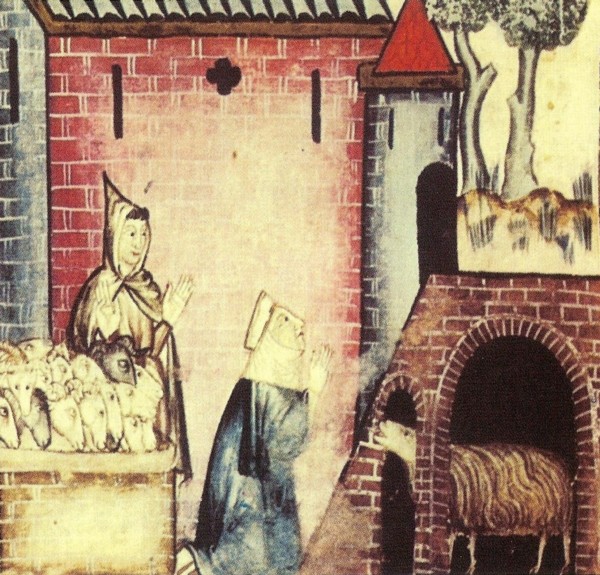Alfonso X el Sabio, 1221-1284.
Cantigas de flauta y tamboril
Eduardo Paniagua, Música Antigua • Enrique Almendros
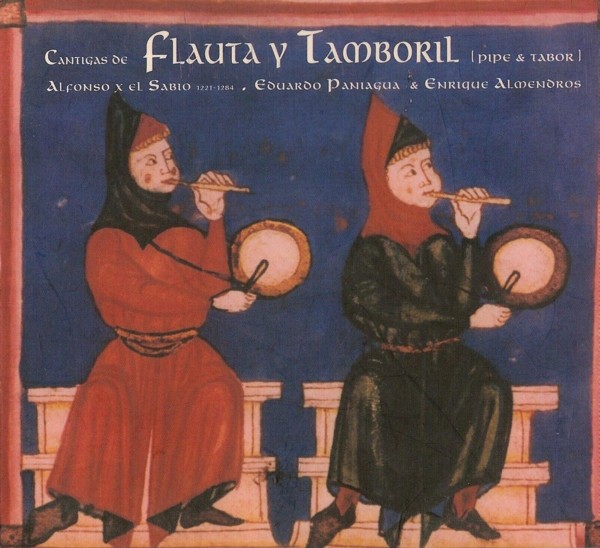
medieval.org
Pneuma «Colección Cantigas» PN-400
2002
1. ALIS Y FELIX [4:34]
CSM 135
[Aquel podedes jurar]
flauta ibicenca, gaita en sol, dulzaina, dulcimer, pandero,
castañuelas ibicencas, espadilla ibicenca y gong
2. LA NAVE CARGADA DE TRIGO [5:32]
CSM 112
[Nas coitas devemos chamar]
flauta eslovaca, dulcimer, flauta dulce, esquilas y
gong
3. DE ROMERÍA SENTADA EN SILLA [5:44]
CSM 153
Quen quer que ten en desden
canto soprano, gaita charra en fa con tamboril salmantino,
chicotén, gaita en do, dulzaina, dulcimer
4. LA OFRENDA DE CLAVOS [6:23]
CSM 106
[Prijon forte nen dultosa]
gaita charra en mi bemol, tambor mallorquín, flauta dulce,
fídula, pandero, tar y qaraqueb
5. LA HARINA DE LOS ROMEROS [3:33]
CSM 157
[Deus por sa Madre castiga a vegadas ben de chão]
flauta corazón dulce, tambor mallorquín, fídula,
salterio y naqaras
6. NO TRABAJAR EN SÁBADO [7:44]
CSM 117
Toda cousa que aa Virgen seja prometuda
canto tenor, chiflo aragonés, chicotén, gaita en do,
dulzaina, fídula, flauta dulce, pandero y campanil
7. LA DONCELLA DE ARRÁS [5:24]
CSM 105
[Gran piadad' e mercee e nobreza]
pito rociero, tamboril salmantino, tambor gnawa, tambor
mallorquín, pandero cuadrado de Peñaparda, dulcimer,
pandereta, espadilla ibicenca y gong
8. LA OVEJA QUE HABLÓ [4:58]
CSM 147
A Madre do que a bestia de Balaam falar fez
canto soprano y tenor, galoubet, flauta pastoril de hueso, arrabel,
tejoletas, pandereta, pandero y arpa de boca
9. LA PATADA DEL MANCEBO [4:40]
CSM 127
[Non pod' ome pela Virgen tanta coita endurar]
flauta corazón dulce, tambor medieval, salterio y flauta dulce
10. LA TAJADA DE CARNE [7:14]
CSM 159
Non sofre Santa Maria de seeren perdidosos
canto soprano y tenor, flauta de sauce, dulcimer, fídula,
tamborete, pandereta, pandero, castañuela ibicenca y campana
11. EL HEREJE DE TOLOSA [3:39]
CSM 208
[Aquele que ena Virgen carne por seer veudo]
gaita en do, flauta dulce, fídula, tambor medieval y daf
12. LA MASA DE PAN [6:24]
CSM 258
Aquela que a seu Fillo viu cinque mil avondar
canto tenor, gaita charra en fa, tamboril salmantino, tambor gnawa,
gaita gallega, dulzaina, salterio y pandereta
13. EL TORO DE PLASENCIA [3:30]
CSM 144
[Con razon é d'averen gran pavor]
fístula en do, chicotén y pandero
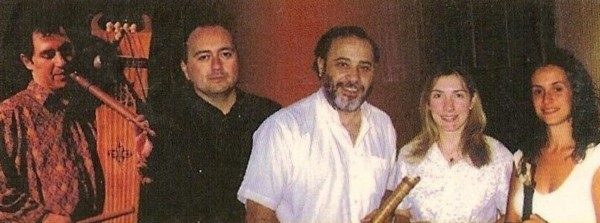
MUSICA ANTIGUA
Eduardo Paniagua
María Luz Álvarez, canto soprano
César Carazo, canto tenor y fídula
Elena Polo, dulzaina aragonesa
Enrique Almendros
Gaita charra en mi bemol, gaita charra en fa, chiflo
aragonés, flauta ibicenca, pito rociero, galoubet, flauta
eslovaca, flauta corazón dulce, fístula en do, flauta
pastoril de hueso, willow flute (flauta de sauce), gaita en do, gaita
en sol, gaita gallega en do, chicotén (salterio percutido),
arrabel (sistro de huesos), tejoletas, tamboril salmantino, tambor
mallorquín, pandero cuadrado de Peñaparda, tambor
medieval, tambor gnawa
Eduardo Paniagua
Dulcimer, salterio, flauta dulce, pandereta, pandero, tambor, daf,
tar, tamborete, naqaras, castañuelas ibicencas, espadilla
ibicenca, gong, qaraqueb, esquilas, campana, campanil y arpa de boca
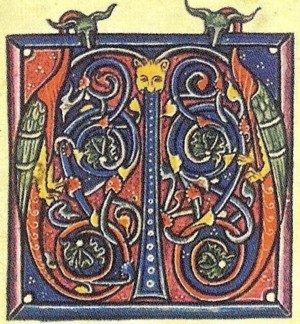
INSTRUMENTOS
• FLAUTAS DE TRES AGUJEROS:
Gaita charra en mi bemol, gaita charra en fa, chiflo aragonés,
flauta ibicenca, pito rociero, galoubet, flauta eslovaca, flauta
corazón dulce, fístula en do
• OTRAS FLAUTAS:
Flauta pastoril de hueso, willow flute (flauta de sauce), flauta dulce
• GAITAS DE FUELLE: Gaita en do, gaita en sol, gaita gallega en do
• OTROS DE LENGUETA: Dulzaina aragonesa
• CUERDA FROTADA: Fídula
• CUERDA PULSADA: Salterio
• CUERDA PERCUTIDA: Chicotén (salterio percutido) y dulcimer
• PERCUSIÓN, MEMBRANAS: Tamboril salmantino, tambor
mallorquín, tambor medieval, tambor cuadrado de
Peñaparda, pandero, daf, pandereta, tar, tamborete, naqaras
• IDIÓFONOS: Arrabel (sistro de huesos), tejoletas, castañuelas
ibicencas, espadilla qaraqueb, esquilas, campana, campanil y arpa de
boca
Sonido: José del Pozo, Axis, Madrid Septiembre 2001-Enero 2002
Diseño gráfico: Pneuma
Portada:
Miniatura de la Cantiga 370 •
Bandejas interiores:
Cantiga 117 y Codex d'Amour, s. XIII
Fotografías de las miniaturas de las Cantigas, Carlos y Eduardo Paniagua
Códice original de la Biblioteca del Monasterio de San Lorenzo de El Escorial
Traducción de cantigas: Jesús Montoya y José Filgueira
English translation: Lesley Ann Shuckburgh
Depósito Legal: M-54893-2001
Distribución: Karonte, Madrid.
Producción: EDUARDO PANIAGUA • 2002 PNEUMA
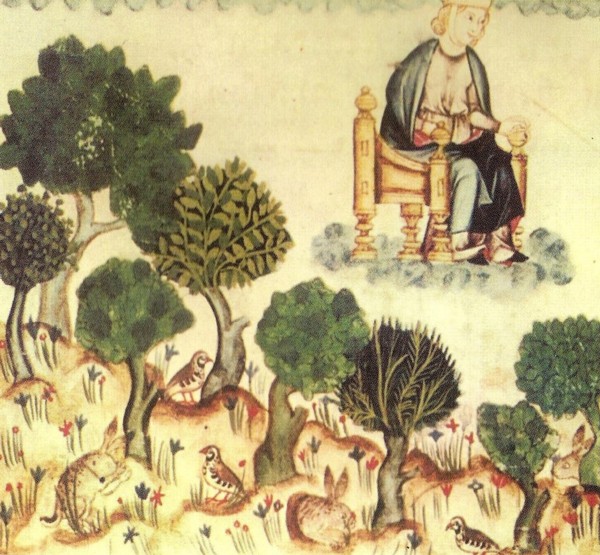
La selección de las melodías de este disco no obedece a
los criterios seguidos anteriormente en la grabación
antológica de las Cantigas de Santa María de Alfonso el
Sabio que estamos realizando desde hace unos años. El motivo que
aglutinó y dio título a los discos de las Cantigas fue,
en unos casos, la localización geográfica de los milagros
y santuarios de Santa María. Es el caso de los discos sobre las
Castigas de Toledo, Sevilla, Jerez, Puerto de Santa María,
Castilla y León, Castilla la Mancha, Francia e Italia. En otros
casos, fue un tema de contenido: Remedios curativos, La vida de
María, Caballeros o el Bestiario.
Este disco inicia una serie en la antología cuyo nexo de
unión es la selección de bellas melodías adaptadas
a un instrumento solista. Para esta ocasión es la
colección de tradicionales flautas de tres agujeros de Enrique
Almendros, indisolublemente acompañadas por los tambores o
cuerdas golpeadas que interpreta simultáneamente el mismo
músico con la otra mano. El canto y otros instrumentos de
percusion, cuerda y viento: dulzaina, gaitas y otros tipos de flautas
acompañan al mundo sonoro de la familia de las flautas de tres
agujeros.
Triple interés ofrece esta muestra; inusual riqueza de
instrumentos, melodías inéditas en primera
grabación mundial y la maestría de Enrique Almendros,
genial interprete de la música tradicional española. Una
perfecta unión entre la culta música histórica y
la viva música tradicional.
Over the last few years each CD in our anthology of
Cantigas de Santa María de Alfonso el Sabio has been
based on a theme. The geographical location of the
miracles and the sanctuaries of the Virgin Mary were the
left motiv for the CDs that grouped together cantigas
concerning Toledo, Seville, Jerez, Puerto de Santa María,
Castilla y León, Castilla la Mancha, France and Italy. On
other recordings the cantigas were chosen according to
their content - Healing Cures, The Life of Mary, Knights or
the Bestiary.
This CD is the first in a series featuring a selection of
melodies adapted to a solo instrument. On this occasion
that instrument is the collection of traditional three-hole
pipes of Enrique Ahnendros, played simultaneously with
drums or a stringed instrument that the same musician
beats with the other hand: The family of three-hole pipes
is accompanied by chant and other percussion, string and
wind instruments: dulzaina, bagpipes and other types of
pipe or flute.
Three features stand out on this recording - the unusual
wealth of instruments, previously un-recorded melodies,
and the skill of Enrique Almendros, expert performer of
traditional Spanish music. A perfect union of historical
cultured music and lively folk music.
EDUARDO PANIAGUA
ENRIQUE ALMENDROS
Nacido en Madrid el 18-11-1962, miembro fundador en 1986 del grupo de
música folk LA MUSGAÑA, realiza un trabajo de
investigación y docencia sobre la música tradicional en
toda la meseta castellana centrado en el repertorio de la flauta y el
tamboril de Salamanca y de la gaita de fole zamorana. Giras por Europa
y Norteamérica, cinco discos y música para obras
teatrales y de danza le han propiciado dos premios nacionales. Ha sido
invitado al espectáculo llamado "Flutopia" que reunió en
gira por el Reino Unido a los más destacados intérpretes
europeos de flauta tradicional.
Born in Madrid on 18 November 1962, he became a
founder member of the folk group LA MUSGAÑA in 1986. He has toured
central Spain in pursuit of his academic interest in traditional music,
concentrating on the Salamanca pipe and tabor repertoire and the Zamoran
bagpipes. Tours of Europe and America, five CDs and music for theatre
and dance have brought him two national prizes. He was invited to
participate in the show "Flutopia" which toured the United Kingdom with
the most celebrated European performers of the traditional flute.
English liner notes

CANTIGAS DE FLAUTA Y TAMBORIL
En el códice "princeps" de las Cantigas, guardado en la
biblioteca del Monasterio de San Lorenzo de El Escorial, encabezando la
cantiga número 370 aparece una de las cuarenta miniaturas con
músicos del manuscrito. Dos interpretes de flauta y tamboril
ataviados de curiosos gorros cónicos. Dentro de la familia de
flautas con bisel, la flauta de tres agujeros (en ocasiones cuatro o
cinco) interpretada con una sola mano, es mucho mas corriente en las
representaciones medievales que la hoy popular flauta dulce. Esa genial
economía de medios que permite con un sólo músico
tener melodía con la flauta en la mano izquierda y
percusión con la mano derecha, hizo muy común esta
combinación. Se puede encontrar muchas variaciones en la mano
derecha: pequeños y grandes tambores, campanas y salterios de
cuerdas golpeadas con una baqueta. Estas flautas de origen pastoril y
que pasaron a ser interpretadas en la música culta, como
demuestra su inclusión en coros religiosos acompañando a
violas y arpas en la pintura de los siglos XIV y XV, y con tesituras de
discanto, tenor y bajo en las ilustraciones de Praetorius en 1618,
actualmente han quedado en la casi perdida música tradicional
popular y en la música militar de algunos países.
FLAUTA Y TAMBORIL
Tradicionalmente al flautista se le ha llamado tamborilero, dando el
nombre prioridad al instrumento del ritmo para la danza frente al
instrumento melódico. Los orígenes de la flauta de tres
agujeros se pierden en la sabiduría tradicional trasmitida de
padres a hijos. Por un lado, pastores autodidactas constructores de sus
propios instrumentos. Por otro, músicos de prestigio social con
la sabiduría y el gusto por las novedades e innovaciones
producidas por la movilidad del viajero trashumante, que es invitado
para amenizar las fiestas religiosas y civiles. A menudo con doble
oficio siendo artesanos, o como los tamborileros sacristanes
visigótico-mozárabes, cuya autoridad queda manifiesta
ante la exigencia de posesión de dotes de mando para dirigir el
baile. Capaz de convocar una multitud y "maestro en dançar", el
tamborilero es la síntesis del concepto de músico popular
medieval. Juglar-mago, con el arcaísmo de sus limitaciones
expresivas y la libertad de las sonoridades y matices que producen los
instrumentos de viento versátiles.
La flauta y el tamboril son instrumentos netamente europeos. Desde
tiempos antiguos en toda la península ibérica se han
venido utilizando, habiendo dejado una huella viva en la música
tradicional especialmente en lo que fue el reino de León y toda
la frontera con Portugal: Asturias, León, Zamora, Salamanca,
Cáceres, Badajoz y Huelva. En los montes Pirineos se encuentra
otro arco de pervivencia, desde el txistu vasco y navarro, el chiflo
aragonés con el salterio golpeado o chicotén, el flabiol
catalán con sus extensiones a las islas Baleares y Valencia. Su
ausencia en la música de tradición musulmana es tan
misteriosa como la ausencia de la flauta oblicua tipo nay en la Europa
occidental.
LA FLAUTA DE TRES AGUJEROS
Se trata de un tubo abierto de madera, caña o hueso, con
embocadura o bisel con una lámina de hueso, madera o metal, que
al soplar hace vibrar la columna de aire. El prototipo tiene en la
parte baja del tubo dos agujeros para los dedos en la parte anterior y
uno en la posterior. Todos para una sola mano. La madera suele ser de
encina, fresno, espino, boj, olivo, nogal, madroño... ; ramas y
raíces cortadas en cuarto menguante de la luna de Enero y
secadas de manera especial. AI ser de materia orgánica los
instrumentos siempre están "vivos" y su sonido varía
según la estación anual y la climatología.
Sabiamente popular, su escala está basada en los
armónicos naturales. Heredera inconsciente de la ciencia
física, geométrica y acústica de los
pitagóricos, teorizada por los griegos de la antigüedad. El
segundo armónico de la nota base del instrumento, por ejemplo
Re, produce lo que se llaman "notas arcaicas", de la escala no
temperada. Se trata de las notas mi bemol y si bemol, mas bajas y
"desafinadas" al oído culto occidental. Esta
característica es similar a la de otras antiguas tradiciones
musicales cultas, por ejemplo ciertos modos andalusíes, que no
tienen única afinación y que guardan por este motivo la
riqueza de poder suscitar diferentes emociones.
La flauta de tres agujeros exige especial destreza al
intérprete, ya que los adornos y giros melódicos, no
posibles en otros tipos de flautas, están en la
combinación de la corta digitación y la expresión
del soplo.
La simbología común para las flautas como: el impulso
masculino, a vida, el sol, la fertilidad... contrastan con la del
tambor: el círculo, la tierra, la luna, la noche, lo femenino...
Así pues, el tamborilero ofrece la conjunción y el
equilibrio de estos símbolos universales produciendo en su
auditorio un efecto excitante, de violenta sonoridad, embriagador y a
la vez tranquilizante, que mueve a bailar, que ahuyenta los animales
nocivos y que relaja a los domésticos.
EL TAMBORIL
También tiene la magia arcaica del efecto inmediato de la
exigencia de atención que produce la "pegada" del parche. Se
compone de una caja cilíndrica de madera, de tronco excavado o
de piezas ensambladas con dos membranas de piel. Esta suele ser de
corzo, cabra, oveja, perro... y sus sistemas con tensores de cuerdas
son apretados con grapas de cuero llamadas agazaderas o castigaderas.
Habitualmente se toca con una sola baqueta; palillo o porra, con la
mano derecha. La técnica del golpeo es rica y variada, pero
siempre es básico el movimiento ágil de muñeca de
abajo a arriba. Los golpes son ubicados en el centro, el borde del
parche y el aro de madera. La sonoridad depende del tamaño y
material del tambor. Existe una gran riqueza de ritmos básicos y
"cojos" o compuestos, por ejemplo en Salamanca: charros, picaos,
perantones, etc.
Sobre la membrana de piel se colocan unas cuerdecillas que al golpear
el parche producen vibraciones estridentes. Mas recientemente, desde el
siglo XVIII, se utilizan cuerdas metálicas que resonantes vibran
por simpatía.
EDUARDO PANIAGUA
3. CSM 153. DE ROMERÍA SENTADA EN SILLA. Quen quer que
ten en desden
Leyenda de traslación aérea con reminiscencia oriental.
Una escéptica mujer de Gascuña, despreciando la
romería de Santa María e Rocamador, dijo que ella no
iría si no le llevaba la silla donde estaba cómodamente
sentada. Al momento la silla voló hasta los pies del altar de la
Virgen.
6. CSM 117. NO TRABAJAR EN SÁBADO. Toda cousa que aa
Virgen seja prometuda
Una mujer que había jurado por Santa María no trabajar en
sábado, olvidó su promesa y cortó y cosió
muchas camisas en su ciudad. Como castigo por ello quedó
paralítica de manos y brazos sin que las muchas medicinas que
probaron la curara. Llorando arrepentida ante el altar de la iglesia de
Santa María de Chartres fue curada.
8. CSM 147. LA OVEJA QUE HABLÓ. A Madre do que a bestia
de Balaam falar fez
Esta cantiga es una joya de la narrativa medieval por su valor
poético y su forma de relato infantil. Una mujer compró
con todo su dinero una ovejita y se la dio a guardar a un pastor.
Cuando llegó el trasquilador el pastor escondió la oveja
y dijo a la mujer que el lobo se la había comido. La mujer
angustiada imploró a Santa María de Rocamador y la oveja
escondida delató al ladrón gritando "heme aquí",
deshaciendo el engaño.
10. CDM 159. LA TAJADA DE CARNE. Non sofre Santa Maria de
seeren perdidosos
La cantiga cuenta una de las extorsiones que sufren los romeros en las
alberguerías. Una criada roba a unos peregrinos que iban a
Rocamador, una tajada de carne preparada en el mesón. Desde el
arcón donde estaba escondida la propia tajada dando saltos
descubre su paradero.
12. CSM 258. LA MASA DE PAN. Aquela que a seu Fillo viu cinque
mil avondar
Una mujer generosa daba a los pobres lo que tenía. Incluso un
año de escasez fue dando como limosna toda la masa para cocer
pan. Ante los lamentos de su hijo por no tener para comer, la mujer con
sorpresa descubrió que no faltaba ni una pizca de la masa que
había tenido antes.
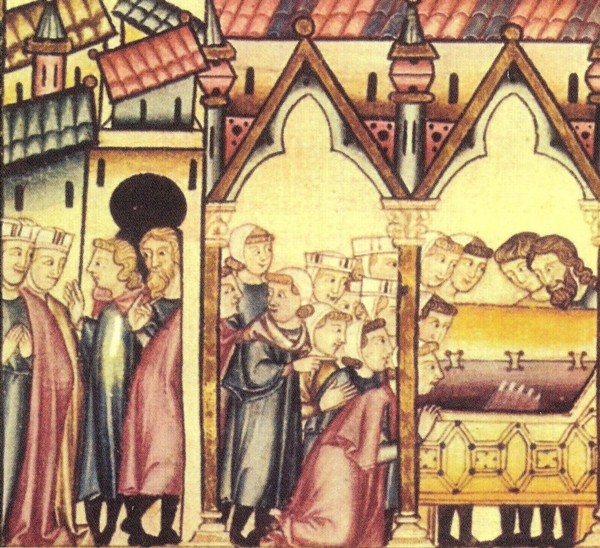
CANTIGAS OF PIPE & TABOR
The "princeps" codex of Cantigas,
kept in the library at the Monastery of San Lorenzo de El Escorial,
contains forty miniatures depicting musicians. One of these, depicting
two pipe and tabor players dressed in strange cone-shaped hats, heads
cantiga 370. Within the family of duct flutes the three-hole flute
(sometimes with four or five holes) played with only one hand, was much
more common in medieval performance than the recorder that is popular
today. This ingenious economy of means led the combination to become
very widespread, as one musician could play the melody on the pipe with
the left hand, and beat the percussion with the right hand at the same
time. There were many variations for the right hand - small and large
drums, bells and psalteries with strings that are struck with a
drumstick. These instruments were originally pastoral but were later
used in cultured music as can be seen in 14th and 15th century paintings
in which they form part of religious choruses accompanying the violas
and harps. Praetorius's illustrations of 1618 show a descant, tenor and
bass version. Nowadays, however, they are only to be found in folk music
and military music in some countries.
PIPE AND TABOR
Traditionally
the piper was known as the drummer, emphasising the rhythm instrument
for dance as opposed to the melodic instrument. The origins of the
three-hole pipe have been lost in the traditional wisdom transmitted
from generation to generation. On the one hand, the musicians were
self-taught shepherds who built their own instruments. On the other,
they were musicians who enjoyed social prestige and as such were invited
to play at religious and civil festivals, yet they possessed the wisdom
and taste for novelty and innovation that the wandering shepherd
gathers on his travels. Often they had two trades, one as a craftsman
and the other as the Visigoth-Mozarab sacristan drummer, an
authoritative figure who needed leadership qualities to organise the
dancing. Able to draw a crowd and "maestro en dançar", the drummer is
the synthesis of the concept of medieval popular musician. Minstrel,
magician, archaic in his limited expression, yet able to make use of the
freedom of sound and nuance that the versatile wind instruments
produce.
The pipe and tabor are basically European instruments.
They have been used in the Iberian Peninsula since ancient times, and
have left their mark on traditional music especially in what was the
kingdom of Leon and the frontier with Portugal: Asturias, León, Zamora,
Salamanca, Cáceres, Badajoz and Huelva. In the Pyrenean mountains the
instrument survives in the form of the Basque and Navarrese txistu, the chiflo from Aragon with its struck psaltery or chicotén, and the flabiol
from Catalonia. By extension it also survives in the Balearic Islands
and Valencia. Its absence from Muslim traditional music is as mysterious
as the absence of the nay
flute, played at an angle, from Western European tradition.
THE THREE-HOLE FLUTE
The
pipe was an open-ended tube made of wood, cane or bone with a
mouthpiece or lip that incorporated a plate of bone, wood or metal below
the mouth hole, forming a flue that caused the column of air to
vibrate. The early examples had two finger holes in the lower part of
the front of the tube and a thumb hole on the back, all for one hand.
The wood used was usually oak, ash, hawthorn, boxwood, olive, walnut,
strawberry tree..., and the branches and roots were cut in the last
quarter of the moon in January and dried in a special way. Being made of
organic material the instruments are always "alive" and their sound
varies with the season and climate.
Obeying the laws of popular
wisdom the scale is based on natural harmonics, which are easy to
understand. The pipe is unaware that it also obeys the laws of physics,
geometry and acoustics found in ancient Greek theory. The second
harmonic of the fundamental tone of the instrument, for example, D,
produces what is known as the "archaic notes" of the untempered scale, E
flat and B flat. These are heard at a lower pitch and are seemingly out
of tune to the trained Western ear. This characteristic is similar to
that of other early cultured musical traditions that do not obey one
tuning system, such as certain andalusí modes, and so dispose of a
wealth of sound that can arouse different emotions. The three-hole pipe
demands special dexterity from the player, since embellishments and
melodic sequences not possible on other types of flute, are the result
of the combination of limited fingering and control of air blown.
The
imagery usually associated with flutes such as the masculine impulse,
life, the sun, fertility..., contrast with the imagery of the drum - the
circle, the earth, the moon, the night, femininity... Thus the drummer
brings these universal symbols together and stimulates his audience with
violent sound that is at once intoxicating and calming. The dancing
begins, dangerous animals are scared away and domestic ones are calmed.
THE TABOR
There
is a certain archaic magic in the immediate effect of one "beat" on the
drumhead that commands the attention of the audience. The tabor is made
of a cylindrical wooden box, a hollowed trunk or assembled pieces, with
two heads, usually made with deerskin, goatskin, sheepskin, or even
dog... The heads were tensioned with a system of cords, with leather
thongs, known as agazaderas or castigaderas, to tighten
them. The tabor is usually played with just one drumstick held in the
right hand. The technique is rich and varied, but the agile up and down
movement of the wrist is always fundamental. The centre or the edge of
the drumhead may be beaten or indeed the wooden hoop. The sound depends
on the size of the drum and what it is made of. There are also a great
variety of basic rhythms and "cojos" or composed rhythms, for example in Salamanca - charros, picaos, perantones, etc.
Strings,
or snares are stretched over the vellum and vibrate loudly when the
drumhead is struck. Since the 18th century, resonant metal strings have
been used causing sympathetic vibration.
EDUARDO PANIAGUA
Traslation: Lesley Ann Shuckburgh
3. CSM 153. ON A PILGRIMAGE SEATED ON A CHAIR. "Quen quer que ten en desden"
This
legend about airborne travel has oriental reminiscences. A sceptical
woman from Gascony is scathing about the pilgrimage of Holy Mary of
Rocamadour, and declares that she will not go unless the chair in which
she is comfortably seated takes her. At once, the chair flies to the
foot of the altar of the Virgin.
6. CSM 117. DAY OF REST ON THE SABATH. "Toda cousa que aa Virgen seja prometuda"
A
woman who had sworn to the Virgin Mary she would not work on the
Sabbath, forgot her promise and cut and sewed many shirts in her town.
As a punishment her hands arms became paralysed and remained so in spite
of the many medicines she tried in search of a cure. Weeping in
repentance before the altar of the church of the Virgin Mary of Chartres
she was healed
8. CSM 147. THE SHEEP THAT SPOKE. "A Madre do que a bestia de Balaam falar fez"
This children's story told in verse makes this cantiga
a gem of medieval narrative. A woman bought a lamb with all her money
and gave it to a shepherd to look after. When the shearer arrived the
shepherd hid the lamb and told the woman that a wolf had eaten it. The
distressed woman prayed to the Virgin Mary of Rocamadour and the hidden
sheep gave the thief away by bleating "I'm over here".
10. CSM 159. THE JOINT OF MEAT. "Non sofre Santa Maria de seeren perdidosos"
The cantiga
deals with the problem of theft to which the pilgrims were often
subject in the hostels. A maid stole a piece of meat prepared at the inn
from some pilgrims who were going to Rocamadour. The meat itself
revealed its hiding place, by jumping up and down in the chest where it
was hidden.
12. CSM 258. THE DOUGH. "Aquela que a seo Fillo viu cinque mil avondar"
A
generous woman gave whatever she could to the poor. One year, when
things were particularly difficult she even gave away the dough before
it was baked. Faced with her son's laments as he had nothing to eat, the
woman discovered to her surprise that not one bit of the dough was
missing.
